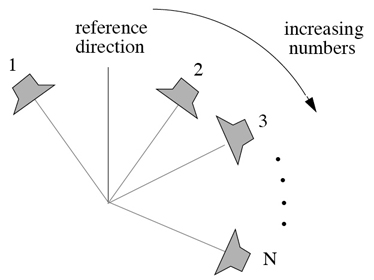Spatialisateur
Spat Introduction
|
The Pan~ ModuleIntroductionThis module receives seven signals according to the output format of the Room~ module: one center channel, two sides channels, and four surround channels (containing respectively the direct sound, the early reflections and the diffuse reverberation). Pan~ can be configured to deliver 2 to 8 signals for feeding the loudspeaker system, and allows dynamic control of the apparent source localization with respect to the listener. From a more general point of view, the Pan~ module can be considered as a conversion matrix which receives a 3/2-Stereo (or 3/4-Stereo) signal and outputs loudspeaker signals for systems of 2 to 8 channels. The control interface in the Pan_ object is divided in two sections: source localization and loudspeaker system configuration. Loudspeaker System ConfigurationThe loudspeakers are assumed to be arranged roughly in a horizontal plane around the listening area. The conversion matrix takes into account the angles where the speakers are placed with respect to a reference listening position and a reference direction. It is assumed that they are all at the same distance from this reference position. If loudspeaker distances differ, the necessary delay and level corrections can be made with the Decoder~ module, described below. Once the system configuration (loudspeaker angles and distance) has been declared, the apparent source localization can be specified with no reference to the positions of the loudspeakers. Nota Bene: The numbering convention adopted in Spat~ for identifying the ouput channels is as follows: Channel number one is the first channel directly left of the reference frontal direction; channels are then given increasing numbers in the clockwise direction (seen from above). Thus, if there is a front channel, it is always given number 2. This convention was chosen so that the left and right front channels of a typical setup (with no center channel) be respectively numbered 1 and 2, and so that, for a multi-channel setup, a rotation around the listener should correspond to naturally increasing numbers.  Convention for Numbering Loudspeakers (view from top) Source LocalizationThe source localization is described in polar coordinates, using two control parameters:
Elevation control is not included, since the loudspeaker setup is assumed to be horizontal. Modifying the azimuth affects the distribution of the intensity of the center channel (direct sound) among the loudspeakers. The method used is derived from Chowning's algorithm [1, 7]. The distribution of the surround channels (containing the diffuse reverberation) is not affected by the source localization control. However, Pan~ extends Chowning's method by allowing for the two side channels (containing the early reflections) to rotate along with the center channel, according to the azimuth control. This method of distributing early reflections improves the reproduction of the room effect and of the apparent distance of the source, yet without involving a geometrical description of the virtual room. Geometrical methods as proposed in [2, 4, 8] could readily be implemented in Room~ by allowing independent panning and continuous variation of the dates of the early reflections, but this additional complexity can be avoided by the panning method used here, while preserving the main perceptual effects. Nota Bene: Modifying the source distance in Pan~ only affects the distribution of signals to the different loudspeakers when this distance becomes shorter than that of the loudspeakers, but does not affect the total intensity of the sound. Larger distances should be reproduced in connection with the room effect. This can be done in Spat~ by combining the effects of the Pan~, Room~, and Source~ modules. A "high-level" control method for this purpose is described in Chapter 4 of this document (see section). |
© CNAC-GP/Ircam and Espaces Nouveaux |